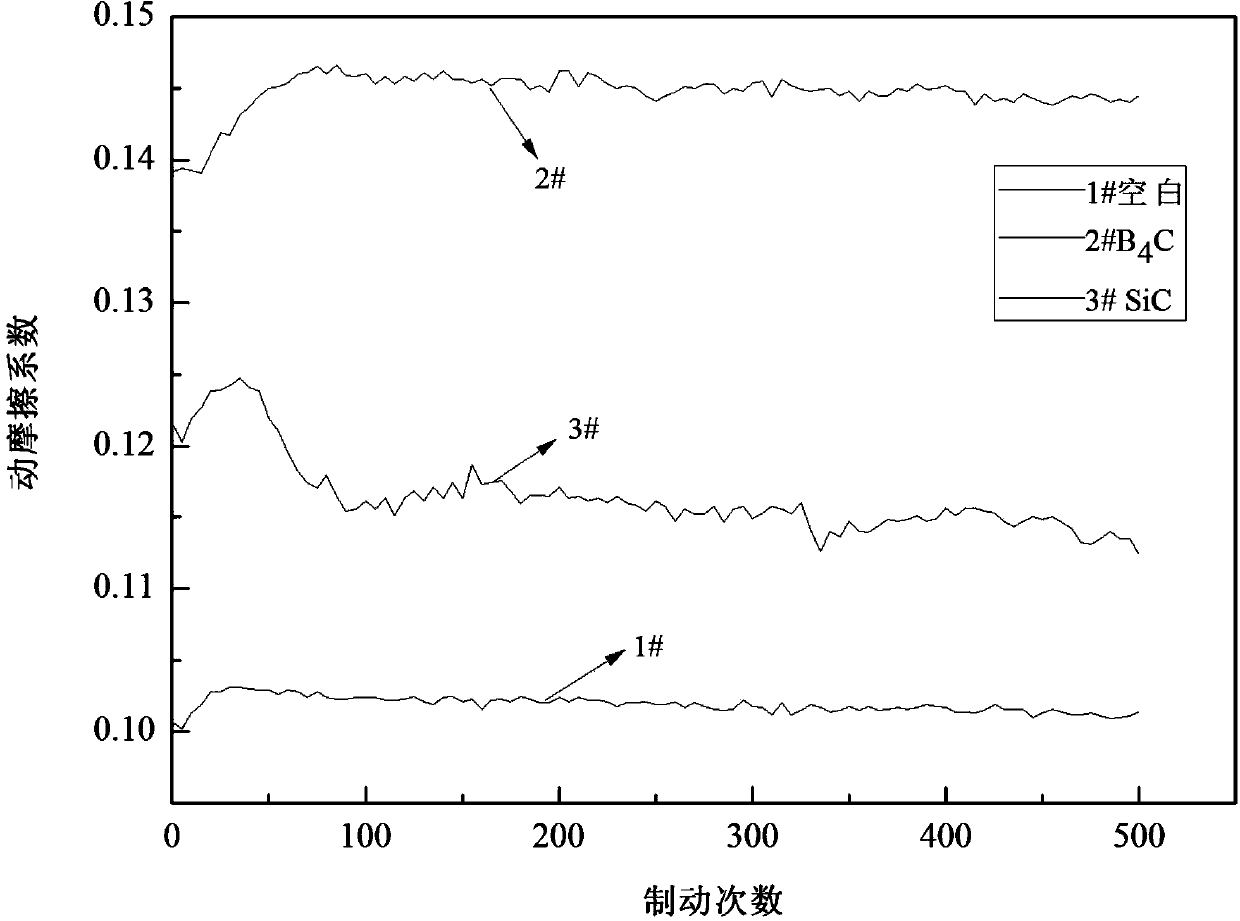Boron carbide reinforced paper-based friction material and preparation method thereof
A technology of paper-based friction material and boron carbide, which is applied in chemical instruments and methods, paper coatings, synthetic cellulose/non-cellulose material pulp/paper, etc., can solve problems such as poor high temperature stability, achieve good thermal performance, enhance Friction material performance and the effect of improving friction performance
- Summary
- Abstract
- Description
- Claims
- Application Information
AI Technical Summary
Problems solved by technology
Method used
Image
Examples
Embodiment 1
[0030] Step 1: Take 0.7g cashew nut shell oil modified phenolic resin and dissolve it in 60mL of absolute ethanol to obtain a phenolic resin solution. After the phenolic resin is fully dissolved, let it stand for 20 hours and seal it for preservation to obtain 60mL of A solution;
[0031] Step 2: Disperse 0.5 g of multi-walled carbon nanotubes with a diameter of 20-60 nm in 150 mL of 0.2% sodium dodecylsulfonate (SDS) aqueous solution, and stir magnetically for 5 hours until the multi-walled carbon nanotubes are uniformly dispersed , to get suspension B;
[0032] Step 3: Add 6g of chopped carbon fiber with a diameter of 6-18μm, 5g of bamboo fiber with a beating degree of 75°SR and 1g of boron carbide to each 60mL of water, and disperse evenly to obtain a mixed solution, then take 100g of suspension B and pour it into C solution is obtained in the mixed solution;
[0033] Step 4: Pour the C solution into the decomposer and disperse it for 1000r, take out the decomposed C solut...
Embodiment 2
[0037] Step 1: Take 1.2g of cashew nut shell oil modified phenolic resin, dissolve it in 70mL of absolute ethanol to obtain a phenolic resin solution, wait until the phenolic resin is fully dissolved, let it stand for 15 hours, seal it and save it, and obtain 70mL of A solution;
[0038] Step 2: Disperse 1 g of multi-walled carbon nanotubes with a diameter of 20-60 nm in 170 mL of an aqueous solution of sodium dodecylsulfonate (SDS) with a mass concentration of 0.25%, and stir magnetically for 5.5 hours until the multi-walled carbon nanotubes are uniformly dispersed. Obtain suspension B;
[0039] Step 3: Add 8g of chopped carbon fiber with a diameter of 6-18μm, 7g of bamboo fiber with a beating degree of 78°SR and 1.5g of boron carbide to each 70mL of water, and disperse evenly to obtain a mixed solution, then take 420g of suspension B and pour into the mixed solution to obtain the C solution;
[0040] Step 4: Pour the C solution into the decomposer and disperse for 1200r, ta...
Embodiment 3
[0043] Step 1: Take 2.25g of cashew nut shell oil modified phenolic resin, dissolve it in 80mL of absolute ethanol to obtain a phenolic resin solution, let it stand for 26 hours after the phenolic resin is fully dissolved, and seal it for storage to obtain 80mL of A solution;
[0044] Step 2: Disperse 2.5 g of multi-walled carbon nanotubes with a diameter of 20-60 nm in 250 mL of 0.3% sodium dodecylsulfonate (SDS) aqueous solution, and stir magnetically for 6 hours until the multi-walled carbon nanotubes are uniformly dispersed , to get suspension B;
[0045] Step 3: Add 10g of chopped carbon fiber with a diameter of 6-18μm, 9g of bamboo fiber with a beating degree of 80°SR and 2.5g of boron carbide to each 80mL of water, and disperse evenly to obtain a mixed solution, then take 200g of suspension B and pour into the mixed solution to obtain the C solution;
[0046] Step 4: Pour the C solution into the deconcentrator and disperse for 1500r, take out the C solution after decon...
PUM
| Property | Measurement | Unit |
|---|---|---|
| diameter | aaaaa | aaaaa |
| diameter | aaaaa | aaaaa |
| friction coefficient | aaaaa | aaaaa |
Abstract
Description
Claims
Application Information
 Login to View More
Login to View More - R&D
- Intellectual Property
- Life Sciences
- Materials
- Tech Scout
- Unparalleled Data Quality
- Higher Quality Content
- 60% Fewer Hallucinations
Browse by: Latest US Patents, China's latest patents, Technical Efficacy Thesaurus, Application Domain, Technology Topic, Popular Technical Reports.
© 2025 PatSnap. All rights reserved.Legal|Privacy policy|Modern Slavery Act Transparency Statement|Sitemap|About US| Contact US: help@patsnap.com

